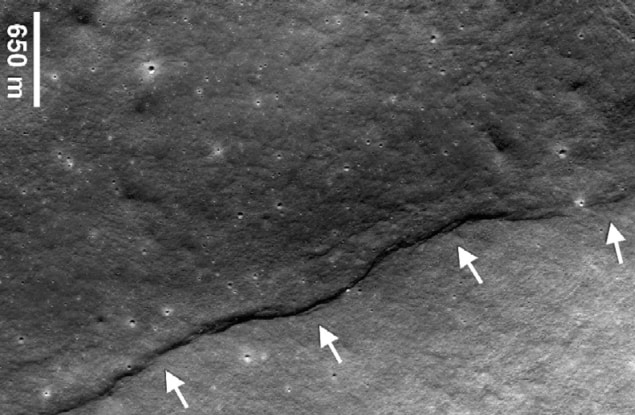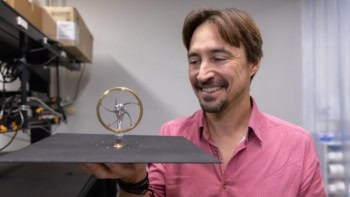
Freshly discovered scars on the face of the Moon reveal that this rocky satellite is shrinking at a relatively rapid pace, say researchers based in Germany and the US. Images collected by NASA’s Lunar Reconnaissance Orbiter show surface faulting that, they say, reflects significant contraction in the Moon’s recent geological past.
The research team used the Lunar Reconnaissance Orbiter Camera (LROC), launched in 2009 aboard the Lunar Reconnaissance Orbiter, the first spacecraft to be launched as part of NASA’s “return to the Moon” initiative. It contains three different cameras designed to deal with both narrow and wide angle high-resolution photography. This high level of detail revealed 14 lunar landforms known as lobate scarps, similar to thrust faults on Earth that result from compressional forces such as plate tectonics.
Half of the located scarps are at high latitudes (±60°), proving that they are globally distributed and not clustered near the equator as previously thought. These factors indicate “recent contraction of the whole Moon, likely due to cooling of the lunar interior,” says Thomas Watters of the Smithsonian Institution’s National Air and Space Museum, lead author of the paper.
I think there is a general impression that the Moon is geologically dead Thomas Watters
A squeezed body
Lobate scarps occur when the surface of the body experiences a compressional force, causing one part of the upper surface to fold and fracture above the other part. In the absence of significant tectonics on the Moon, the researchers believe this is due to cooling of the lunar core. As the core of the Moon cooled it also shrunk, applying surface stress to the brittle lunar crust and causing it to rupture and split.
“On relatively small planetary bodies, like Mercury, the Moon, and possibly some of the icy satellites, it’s long been thought that the original cooling of the body very early in its history could cause a global contraction in the size of the body,” explains Dr Peter Grindrod of the Department of Earth Sciences at University College London, who was not involved in this report. “This is a fairly easy concept, as it’s just to do with the volume decreasing as the temperature decreases.”
However, in the case of the Moon, this faulting appears to have been delayed. Through analysis of the scarps’ interaction with other nearby surface features of known age, including craters, the researchers infer that the Moon has contracted radially by 100 m in the past 1 billion years. This is in keeping with the “crisp, un-degraded appearance” of the scarps, which Watters says is the strongest evidence of their young age.
More comprehensive picture
Lobate scarps have been observed on the surface of the Moon before, from images taken by the panoramic cameras aboard the Apollo 15, 16 and 17 missions. However, these earlier missions were confined to the equatorial zone of the Moon’s surface. Using the LROC the team has managed to acquire comprehensive images of the lunar surface at higher latitudes.
The Moon’s surface is stressed and marked by many different geological features. Most large-scale crustal deformation is associated with surface features such as basins and maria – dark, basaltic plains formed by ancient volcanic eruptions. The lunar lobate scarps are generally found outside of these mare-filled basins, and they are the most common tectonic landform on the far side of the Moon. They are relatively small-scale structures with a maximum relief of less than 100 m, unlike those found on Mercury and Mars.
“I think there is a general impression that the Moon is geologically dead – that everything of geologic significance that happened to the Moon happened billions of years ago,” says Watters. “Our results suggest this is not the case. The Moon may still be geologically and tectonically active and still contracting today.”
This research is described in Science.



